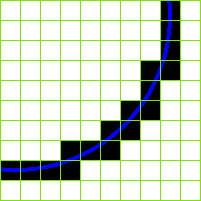sub-pixel resolution on:
[Wikipedia]
[Google]
[Amazon]
 In
In
Accurate particle position measurement from images
. Y. Feng, J. Goree, and Bin Liu, ''Review of Scientific Instruments'', Vol. 78, 053704 (2007); also selected for ''Virtual Journal of Biological Physics Research'', Vol. 13, (2007).
digital image processing
Digital image processing is the use of a digital computer to process digital images through an algorithm. As a subcategory or field of digital signal processing, digital image processing has many advantages over analog image processing. It allo ...
, sub-pixel resolution can be obtained in images constructed from sources with information exceeding the nominal pixel resolution of said images.
Example
For example, if the image of a ship of length , viewed side-on, is 500 pixels long, the nominal resolution (pixel size) on the side of the ship facing the camera is . Now sub-pixel resolution of well resolved features can measure ship movements which are an order of magnitude (10×) smaller. Movement is specifically mentioned here because measuring absolute positions requires an accurate lens model and known reference points within the image to achieve sub-pixel position accuracy. Small movements can however be measured (down to 1 cm) with simple calibration procedures. Specific fit functions often suffer specific bias with respect to image pixel boundaries. Users should therefore take care to avoid these "pixel locking" (or "peak locking") effects.. Y. Feng, J. Goree, and Bin Liu, ''Review of Scientific Instruments'', Vol. 78, 053704 (2007); also selected for ''Virtual Journal of Biological Physics Research'', Vol. 13, (2007).
Determining feasibility
Whether features in a digital image are sharp enough to achieve sub-pixel resolution can be quantified by measuring thepoint spread function
The point spread function (PSF) describes the response of a focused optical imaging system to a point source or point object. A more general term for the PSF is the system's impulse response; the PSF is the impulse response or impulse response ...
(PSF) of an isolated point in the image. If the image does not contain isolated points, similar methods can be applied to edges in the image. It is also important when attempting sub-pixel resolution to keep image noise to a minimum. This, in the case of a stationary scene, can be measured from a time series of images. Appropriate pixel averaging, through both time (for stationary images) and space (for uniform regions of the image) is often used to prepare the image for sub-pixel resolution measurements.
See also
*Acutance
In photography, acutance describes a subjective perception of visual acuity that is related to the edge contrast of an image. Acutance is related to the magnitude of the gradient of brightness. Due to the nature of the human visual system, an ...
* Hyperacuity
References
Sources
# # # {{DEFAULTSORT:Sub-Pixel Resolution Image processing